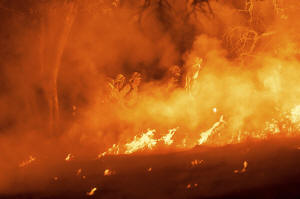Wildfires threaten homes in Oregon and California, prompting hundreds of
evacuations
[August 25, 2025]
By TAMMY WEBBER
Thousands of homes in Northern California wine country and central
Oregon were under evacuation orders and warnings Sunday as firefighting
crews battled wildfires in dry, hot weather.
The Pickett Fire, which had charred about 10 square miles (26 square
kilometers) of Napa County, was just 11% contained by Sunday evening,
according to the California Department of Forestry & Fire Protection, or
Cal Fire.
About 150 people were ordered to leave their homes, while another 360
were under evacuation warnings as the fire threatened 500 structures
near Aetna Springs and Pope Valley, 80 miles (127 kilometers) north of
San Francisco, said Cal Fire spokesperson Jason Clay. Some evacuation
orders were later lifted.
In Oregon, the 29-square-mile (75-square-kilometer) Flat Fire in
Deschutes and Jefferson counties had about 4,000 homes under various
levels of evacuation notice, including 1,000 with orders to leave
immediately, according to the state Fire Marshal’s Office.
Firefighters were able to cut containment lines and continued to
suppress fires in some residential areas. However, they faced
significant challenges with difficult terrain, low humidity and
triple-digit temperatures in some areas, officials said.

Some homes have burned, and officials said they were working to confirm
the status of structures.
More than 1,230 firefighters backed by 10 helicopters were battling the
California fire, which began in a remote area Thursday after a week of
hot weather. The cause of the fire is under investigation.
Residents of the western United States have been sweltering in a heat
wave that hospitalized some people, with temperatures hitting dangerous
levels throughout the weekend in Washington, Oregon, Southern
California, Nevada and Arizona.
Clay said the weather has moderated since the California fire began,
with Sunday’s high about 94 Fahrenheit (34 Celsius). But humidity levels
were expected to drop with increasing winds later in the day.
“That’s been a driving factor in the afternoons since we’ve seen the
fire activity pick up for the last three days,” Clay said, adding that
“support from all up and down California has been critical to our
efforts.”
The Pickett Fire began in the same area as the much larger Glass Fire in
2020, which crossed into Sonoma County and eventually burned about 105
square miles (272 square kilometers) and more than 1,500 structures.
[to top of second column]
|

Firefighters battle the Pickett Fire burning in the Aetna Springs
area of Napa County, Calif., on Saturday, Aug. 23, 2025. (AP
Photo/Noah Berger)

The 2020 blaze was driven by wind, while the current conflagration is
fueled mainly by dry vegetation on steep slopes — some of it dead and
downed trees left over from the Glass Fire and some of it grass and
brush that grew back and then dried out again, said Clay.
The area of the Oregon fire is in a high desert climate, where dried
grasses and juniper trees are burning and fire is racing through canyon
areas where it’s challenging to create containment lines, said Jason
Carr, Deschutes County sheriff’s spokesman.
The fire began Thursday night and grew quickly amid hot, gusty
conditions. Fire officials were keeping an eye on isolated thunderstorms
in southern Oregon that could drift north on Sunday, state Fire Marshals
spokesman Chris Schimmer said in a video posted to Facebook.
"If we get thunderstorms that roll through, it can ... cause the fire to
jump (containment) lines,” said Carr, adding the downdrafts can push
fire in multiple directions.
In central California, the state's largest blaze this year, the Gifford
Fire, was at 95% containment Sunday after charring nearly 206 square
miles (534 square kilometers) of San Luis Obispo and Santa Barbara
counties since erupting on Aug. 1. The cause is under investigation.
Although it's difficult to directly tie a single fire or weather event
directly to climate change, scientists say human-caused warming from
burning fossil fuels like coal and gas is causing more intense heat
waves and droughts, which in turn set the stage for more destructive
wildfires.
___
Associated Press writer Christopher Weber contributed from Los Angeles.
All contents © copyright 2025 Associated Press. All rights reserved
 |